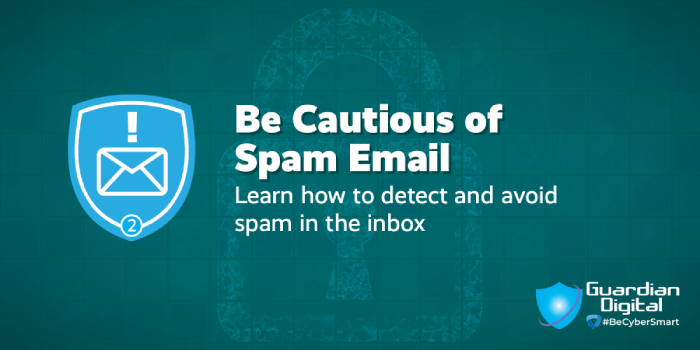Tip - Being Cautious of Spam Email

Learn how to detect and avoid spam in the inbox.
Spam email, or junk email, refers to unsolicited messages sent in bulk. Along with decreasing productivity and causing aggravation, spam can also be a security threat. These emails may contain malicious links or attachments and are often a vector for phishing and malware attacks.
While it is blatantly obvious that certain emails are spam, some spammers craft highly deceptive messages that are difficult to differentiate from legitimate emails. Thus, it is critical to be familiar with the following best practices for identifying and avoiding spam.
Tips & Best Practices for Avoiding Spam Email
Look for unknown, suspicious or spoofed email addresses. Pay attention to the sender’s email address, especially if a message seems strange or suspicious. Attackers often use spoofed email addresses to deceive recipients.
Be wary of unfamiliar links or unexpected attachments. Refrain from clicking on links or downloading files in emails unless you trust the source. Malware, viruses, and other types of malicious material can be easily downloaded through malicious attachments or links.
Look for misspelled words or added characters within the subject or body of an email. Spammers often intentionally misspell words or insert additional characters within their messages to evade spam filtration software. Be cautious of emails that contain spelling and/or grammatical errors.
Think before you respond, and watch for offers or opportunities that seem too good to be true. If the content in an email seems too good to be true, it likely is! Such emails are often phishing scams trying to steal credentials or other sensitive information. Remember to never give out personal information such as passwords, social security numbers, or credit card numbers via email. Legitimate businesses will never ask for it, and sharing sensitive information can result in data theft, monetary losses, and in some cases, identity theft.
Want to learn more about how to secure business email against spam and other dangerous threats? Get in Touch>>
CyberSecurity Month
- Tip - Avoid Phishing Emails
- Tip - Being Cautious of Spam Email
- Tip - Be Wary of Malicious URLs
- Tip - Protect Against Spoofing & Sender Fraud
- Tip - Protect the Privacy of Your Email with TLS
- Tip - Don't Rely on Native Microsoft 365 Email Protection Alone
- Tip - Implement TLS to Keep Your Email Secure
- Tip - Endpoint Security Is Not Enough
- Tip - Conduct Regular Email Security Audits
- Tip - Configure Email Account Settings with Security in Mind
- Tip - Learn How To Spot Threats to Business Email
- Tip - Backing up Your Data and Isolate Your Backups Offline
- Tip - Protect Business Email from Phishing Attacks
- Avoid Sending Sensitive Information Over Email
- Tip - Learn About Malicious Links
- Tip - Prevent Zero-Day Attacks
- Tip - Business Email Is for Business Only
- Tip - Learn How To Identify Social Engineering Attacks
- Tip - Know Your Email Risk
- Tip - Safeguard Your Inbox from Malicious Mail
- Tip - Understand How Phishing Attacks Are Carried Out
- Tip - Know the Steps in a Spear Phishing Attack
- Tip - Familiarize Yourself with the Anatomy of a Whaling Attack
- Tip - Understand How Malware Attacks Work
- Tip - Learn the Steps in a Ransomware Attack
- Tip - Understand the Phases of a Business Email Compromise (BEC) Attack
- Tip - Know What Zero-Day Attack Is & How It Works
- Tip - Familiarize Yourself with the Phases of an Account Takeover (ATO) & Lateral Phishing Attack
- Tip - Learn the Steps in a Social Engineering Attack
- Tip - Understand the Types of Email Viruses to Be on the Lookout For